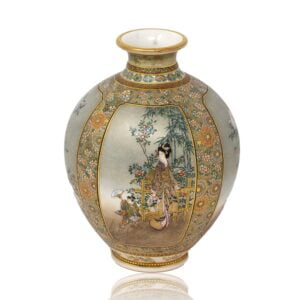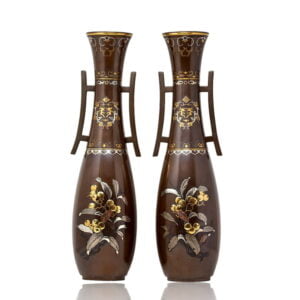Description
Dai Nippon Yuzan zo 大日本 友山造
From our Japanese collection we are delighted to introduce this unusual Japanese Satsuma Vase by Yuzan 友山. The Satsuma Vase of good size potted in ovoid form with a rolled rim and pinched neck is beautifully executed with two large scenes. The first scene features a highly unusual painting with a vast mountainous landscape filled with trees, pagoda buildings, figures and a river. To the foreground five figures are seen in poses as they try to jump out the way of a spilled basket of octopus, fish, and lobsters, a wonderful and highly detailed scene which is a rare composition. The rear scene is painted with large trees and overhanging cherry blossom with a ground of foliage and stunning blossoming Peony 牡丹 flowers amongst others, there are a flock of birds to the top right hand corner with green-blue hues. Each scene is bordered by a thick risen enamel gilt border to the top and bottom with a cobalt body with gilt draped and scrolling vines and a forms of the Paulownia Seal. The base of the Satsuma Vase is signed in gold with a Shimazu Mon and six character mark reading 大日本 友山造 Dai Nippon (Great Japan) Yuzan zo (made by Yuzan) and dates to the Meiji Period (1868-1912) circa 1895.
Peony 牡丹
in Japanese it is known as the King of Flowers (botan). The peony is a Japanese flower that is used as a symbol of good fortune, wealth, nobility, bravery and honour.
Shimazu Mon
Shimazu 島津 is the name of the clan family that ruled the Satsuma province and the family crest, the Mon is a cross with a circle. The earliest Shimazu Mon was painted in Gosu blue and was believed to be painted in direct relationship to the Shimazu clan and often pre Meiji Period. A mon that is depicted in black, gold or red has no direct link to the Shimazu family and always dates from a period after Edo.
Paulownia Seal
is a symbol that took inspiration from the Paulownia tree. It was used by the Toyotomi clan who ruled over Japan before the edo period. It is written in Japanese history that when a paulownia leaf falls, the world’s autumn is known. The ‘world’s autumn’ implies the changing of the dynasty. Since paulownia leaves are the crest of the Tyotomi family that ruled Japan in the sixteenth century and was ruined by the Tokugawa, the word hito ha (“one paulownia leaf”) implies a sort of sadness. The Paulownia seal is used today as the official emblem of the Japanese government.
MEIJI PERIOD (1868-1912)
The Meiji era marked Japan’s transformation into a modern nation and a golden age of decorative arts. With the end of samurai rule and Japan’s opening to the West, artisans produced works of exceptional quality for both domestic and international audiences. Supported by the government through world fairs and Imperial commissions, Japanese lacquerware, cloisonné, satsuma ceramics, bronzes, and ivory carvings reached collectors worldwide. Many leading artists of the time, including Makuzu Kozan and Namikawa Yasuyuki, were honoured as Imperial Household Artists, ensuring the Meiji period remains one of the most celebrated eras of Japanese art.
For further information please see our article Japanese Meiji Period: Art, Collecting, and Cultural Transformation.
SATSUMA WARE
Satsuma ware originated in southern Kyūshū around 1600 and developed into one of Japan’s most recognisable ceramics. Early Ko-Satsuma pieces were rustic, dark-clay wares made for everyday use, while the later Kyō-Satsuma style became famous worldwide during the Meiji period.
Characterised by ivory crackled glaze, delicate overglaze enamels, and lavish gilding, export Satsuma appealed strongly to Western collectors. Designs often feature landscapes, flowers, figures, and scenes from Japanese life and mythology. Renowned artists such as Yabu Meizan, Ryozan, and the Kinkōzan workshop produced some of the finest examples, which remain highly sought after today. Genuine Satsuma can often be identified by the Shimazu crest, artist signatures, or the mark “Dai Nippon” used during the Meiji era.
For further information on the history of Satsuma Wear please see our article Japanese Satsuma Ware.
Measurements
31.5cm High x 18cm Diameter ( 12.4 x 7.1 Inches)
Condition
Very Good condition, some rubbing to the gilding
With every purchase from Jacksons Antique, you will receive our latest product guides, full tracking information so you can monitor your shipment from start to finish and our personal no-hassle, money-back policy giving you that extra confidence when purchasing.












































